Planting Bucephalandra caterina
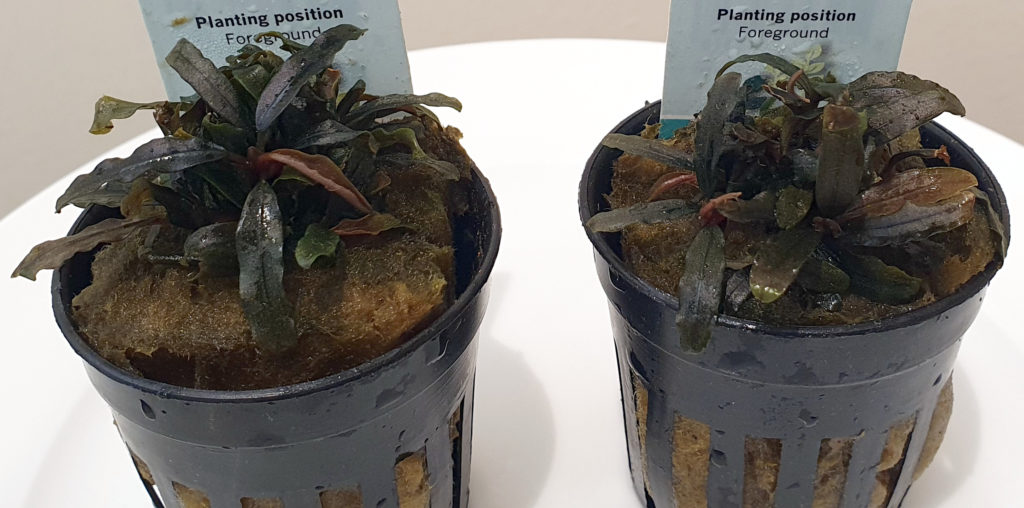
Looking for a replacement epiphyte for the failed Anubias nana ‘Snow White’, I’ve plumped for Bucephalandra caterina. There just isn’t much availability for aquatic plants in general in the United Kingdom recently, and the availability of Anubias and Bucephalandra varieties seems extraordinarily poor especially for the smaller size varietals. I managed to score two pots from Pro Shrimp, as grown by Aquadip, and they arrived today.
Species and varietal names are not very well defined for Bucephalandra with several hundred types known (or claimed). There’s some question as to whether Bucephalandra caterina is (or is not) the same thing as Bucephalandra ‘Mini Needle Leaf’.
Bucephalandra caterina pots are each their own individual plants
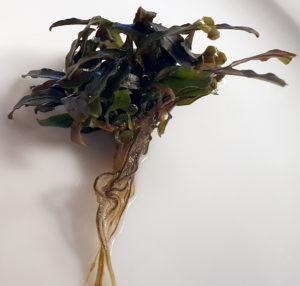

I was expecting each pot to be composed of a number of plantlets that could be easily teased apart and planted separately, like the Cryptocoryne lutea ‘Hobbit’, but this was not the case. Once the rockwool was removed from the roots it was clear that each pot was its own defined thing that was not obviously subdividable. I suppose I should have expected that from a plant that grows from a rhizome, but I was thinking of the Anubias nana ‘Snow White’ tissue culture pot where there were many individual plantlets even though Anubias also grows from a rhizome – that might be a difference between growth in pots vs. in tissue culture. I thought about cutting the Bucephalandra in half with sharp scissors, particularly the one on the left that sort of looked like it had a semi-obvious point where it could be divided, but in the end decided to plant them ‘as is’.
Can you plant Bucephalandra in substrate?
The short answer is “no”. The various species of both Bucephalandra and Anubias are ephiphytes* – they grow with roots attached to something solid rather than embedded in substrate. The roots support the rhizome, a type of horizontal stem, from which vertical stems supporting leaves arise. Rhizomes, if buried in substrate, tend to rot which kills the plant. The trick with planting epiphytes such as Bucephalandra is getting them to stay in place on a solid surface long enough for the roots to start clinging. Some common methods for temporarily fixing epiphytes in place when intially planted are tying them with thread or wire, or even spot supergluing them to a solid support.
Planting trees on the mountain
As I tried before with the Anubias nana ‘Snow white’, I’m having a go with simply wedging the plants into gaps in the sculpture. One plant fit well into a gap at the top of the mountain, whilst I wedged the more extended-looking plant (the one I considered cutting in half) into a larger crevasse at the bottom. With some luck the roots will grab on and lock them into place. The root systems on these plants are considerably more substantial than those on in vitro tissue culture cup plantlets.
There’s an idea that Bucephalandra do best in low lighting, because they grow very slowly and so have less likelihood of being covered in algae where light levels are lower. We’ll see how we go… if algae starts to look problematic I might be able to relocate them to less well-lit parts of the sculpture.
*Interesting fact: although not often thought of this way, green algae are perhaps the most common and successful aquarium ephiphyte, growing on solid surfaces whether walls, hardscape, or leaves of non-epiphyte plants.
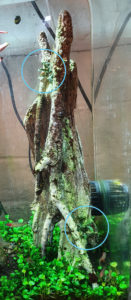
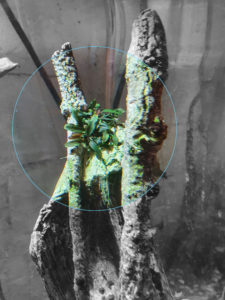
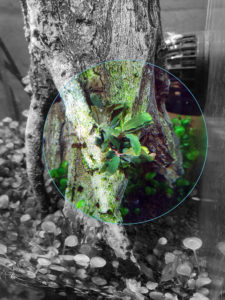
1 thought on “Planting Bucephalandra”